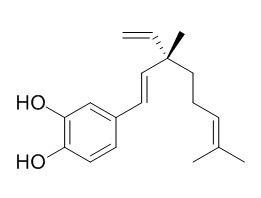3-Hydroxybakuchiol
3-Hydroxybakuchiol exerts cytotoxic and anti-proliferative effects on the TA3/Ha mouse mammary adenocarcinoma cell line and induces a decrease in the mitochondrial transmembrane potential, the activation of caspase-3, the opening of the mitochondrial permeability transport pore (MPTP) and nuclear DNA fragmentation.3-Hydroxybakuchiol has antitumor activity resulting from interactions with the ETC, a system that is already deficient in cancer cells.
Inquire / Order:
manager@chemfaces.com
Technical Inquiries:
service@chemfaces.com
Tel:
+86-27-84237783
Fax:
+86-27-84254680
Address:
1 Building, No. 83, CheCheng Rd., Wuhan Economic and Technological Development Zone, Wuhan, Hubei 430056, PRC
Providing storage is as stated on the product vial and the vial is kept tightly sealed, the product can be stored for up to
24 months(2-8C).
Wherever possible, you should prepare and use solutions on the same day. However, if you need to make up stock solutions in advance, we recommend that you store the solution as aliquots in tightly sealed vials at -20C. Generally, these will be useable for up to two weeks. Before use, and prior to opening the vial we recommend that you allow your product to equilibrate to room temperature for at least 1 hour.
Need more advice on solubility, usage and handling? Please email to: service@chemfaces.com
The packaging of the product may have turned upside down during transportation, resulting in the natural compounds adhering to the neck or cap of the vial. take the vial out of its packaging and gently shake to let the compounds fall to the bottom of the vial. for liquid products, centrifuge at 200-500 RPM to gather the liquid at the bottom of the vial. try to avoid loss or contamination during handling.
Food Science&Tech. Res.2022, 28(2):123-132.
Molecules.2020, 25(3):734
Front Chem.2023, 11:1245071.
FASEB J.2019, 33(8):9685-9694
Food Res Int.2024, 197(Pt 1):115244.
Biomedicines.2024, 12(3):495.
Pharmaceuticals (Basel).2022, 15(8):982.
Plos One.2020, 10.1371
Biosci. Rep.2020, 10.1024
Current Pharmaceutical Analysis2017, 13(5)
Related and Featured Products
Toxicol Appl Pharmacol. 2013 Oct 15;272(2):356-64.
Tumor cell death induced by the inhibition of mitochondrial electron transport: the effect of 3-hydroxybakuchiol.[Pubmed:
23777606]
Changes in mitochondrial ATP synthesis can affect the function of tumor cells due to the dependence of the first step of glycolysis on mitochondrial ATP. The oxidative phosphorylation (OXPHOS) system is responsible for the synthesis of approximately 90% of the ATP in normal cells and up to 50% in most glycolytic cancers; therefore, inhibition of the electron transport chain (ETC) emerges as an attractive therapeutic target.
METHODS AND RESULTS:
We studied the effect of a lipophilic isoprenylated catechol, 3-Hydroxybakuchiol (3-OHbk), a putative ETC inhibitor isolated from Psoralea glandulosa. 3-OHbk exerted cytotoxic and anti-proliferative effects on the TA3/Ha mouse mammary adenocarcinoma cell line and induced a decrease in the mitochondrial transmembrane potential, the activation of caspase-3, the opening of the mitochondrial permeability transport pore (MPTP) and nuclear DNA fragmentation. Additionally, 3-OHbk inhibited oxygen consumption, an effect that was completely reversed by succinate (an electron donor for Complex II) and duroquinol (electron donor for Complex III), suggesting that 3-OHbk disrupted the electron flow at the level of Complex I. The inhibition of OXPHOS did not increase the level of reactive oxygen species (ROS) but caused a large decrease in the intracellular ATP level. ETC inhibitors have been shown to induce cell death through necrosis and apoptosis by increasing ROS generation. Nevertheless, we demonstrated that 3-OHbk inhibited the ETC and induced apoptosis through an interaction with Complex I. By delivering electrons directly to Complex III with duroquinol, cell death was almost completely abrogated.
CONCLUSIONS:
These results suggest that 3-OHbk has antitumor activity resulting from interactions with the ETC, a system that is already deficient in cancer cells.



